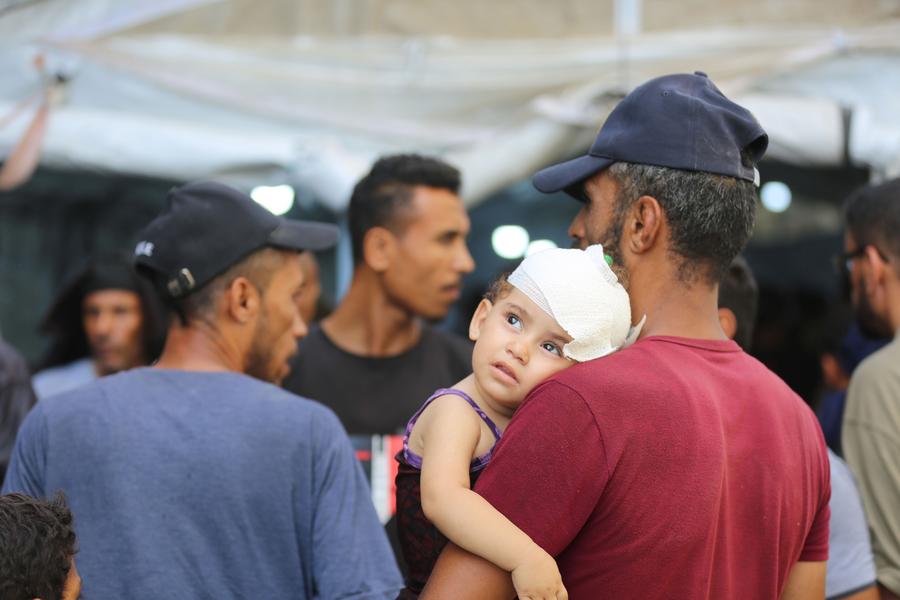
Wounded people are seen after Israeli attacks in the Nuseirat refugee camp in the central Gaza Strip on June 8, 2024. (Photo by Marwan Daoud /Xinhua)
GAZA, June 9 -- Pedestrians can hardly walk through the streets of the Nuseirat refugee camp in central Gaza Strip on Sunday, which has been transformed overnight into a devastated area with the smell of death.
Burned cars, destroyed houses, and bloodstains from the victims are found on the camp's roads and in its alleys after Israeli special forces launched a military operation in the camp to free four Israeli hostages on Saturday.
As Israeli troops entered the camp, warplanes launched a series of violent raids on dozens of targets inside the camp, mostly civilian houses, according to the media office of the Hamas-run government.
At least 274 Palestinians were killed and more than 698 others injured during the Israeli military operation, according to figures released by the Hamas-run health authorities on Sunday.
A man shows the debris after Israeli attacks in the Nuseirat refugee camp in the central Gaza Strip on June 8, 2024. (Photo by Marwan Daoud /Xinhua)
"I was drinking a cup of coffee on the balcony of my house overlooking the street. Everything was normal: passers-by and vendors in the street, children playing in the sun, but everything changed in an instant," recalled Othman Zaki, a resident of the Nuseirat camp.
"Suddenly, Israeli planes started bombing violently everywhere. No one understood anything. Everyone started running without knowing where to go safely," said the 27-year-old man.
"The continuous bombing, the rapid events, and the bodies of the victims lying everywhere -- no one can describe it," said Ahmed Shaaban, a displaced Palestinian man.
"We couldn't save anyone. The situation was catastrophic and crazy. No one could have imagined it, not even in their nightmares," he added.
Since early Sunday morning, the 42-year-old father of six has been trying in vain to identify landmarks in his neighborhood. The street where he once lived with his family has been reduced to rubble.
"We can only see the rubble of houses destroyed by Israeli airstrikes. The dead and wounded were lying on the sides of the road. No one could save them due to the violent and continuous bombing," he said with teary eyes.
When the bombing, which lasted for more than half an hour, finally subsided, Shaaban and his neighbors started to leave and seek safety. "We were shocked by what we saw. The victims were everywhere," he recalled.
In a desperate attempt to rescue the injured people, they used anything that could move -- vehicles, bicycles, even donkey carts -- to transport them to hospitals.
This photo taken on June 8, 2024 shows buildings and vehicles damaged during Israeli attacks in the Nuseirat refugee camp in the central Gaza Strip. (Photo by Marwan Daoud /Xinhua)
Yahya Ayoub from the city of Beit Hanoun in the northern Gaza Strip described how the bombing forced many displaced people and dozens of residents of Nuseirat camp to flee their homes.
"Destruction is everywhere here. Houses were burned, some destroyed. Victims were killed inside their homes without understanding what was happening or what their fault was," Ayoub said.
With a tone of sadness, Ayoub said he could not believe he had survived the bombing. He recounted carrying an injured, unconscious child from the street, running a long distance until he found a car to take the child to the hospital.
"I still do not know the condition of the child, but I hope he is fine and that the doctors succeed in saving his life," he said.
Smoke rises after Israeli attacks in the Nuseirat refugee camp in the central Gaza Strip on June 8, 2024. (Photo by Marwan Daoud /Xinhua)■










